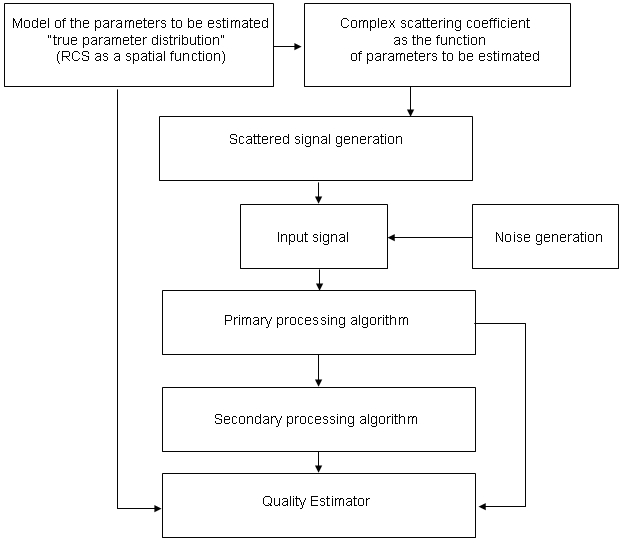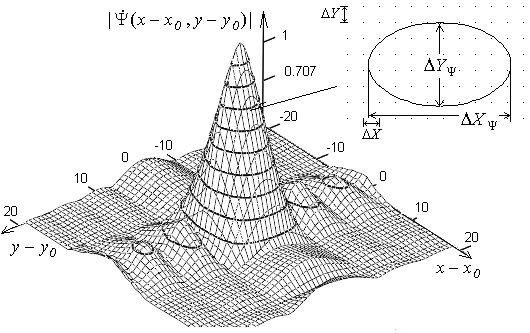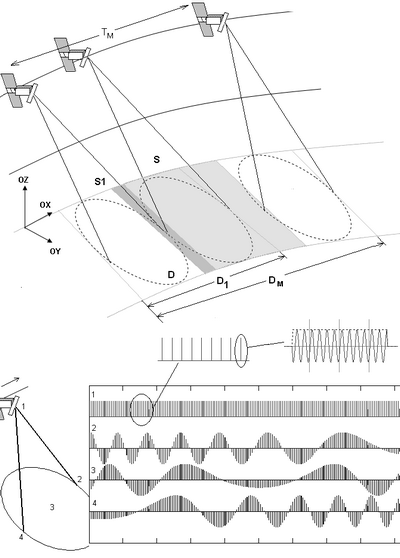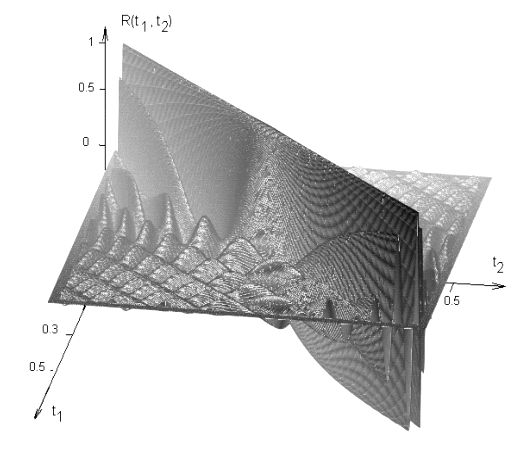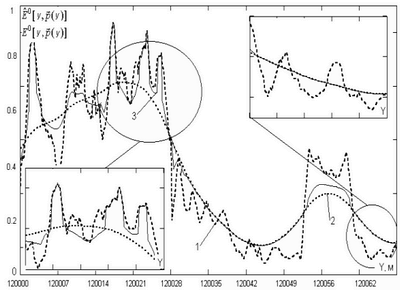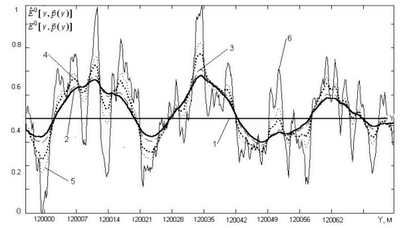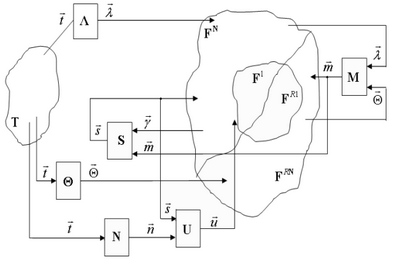|
|
Multiposition Synthetic Aperture Radar (MPSAR) Alexander V Ksendzuk |
| Main Page |
10. Multiposition SAR. Modeling principles. Why the model not real data? There are two main reasons: 1. Real SAR/radar experiment is much more expensive than modelling. 2. One quite good model may be changed to analyse in other conditions or to analyse other systems. 3. If we process real data with different primary (estimation information from the input signal) and secondary (processing of the radar images) we just can say it is different because we dont know real values. Therefore modelling allows to estimate errors of different algorithms because we know true. In this section modelling principles are discussed. 10.1. General Modeling Algorithm. Estimation any other parameters even non-stationary in time, but for clarity we consider RCS estimation of the stationary scene). Modelling algorithm is shown in Fig. 10.1. RCS as the spatial function may be represented by any random or deterministic function but usually real radar images are used. Complex scattering coefficient is a spatial function value of which presents in signal model (see equation 2.1 in Signal Model section). Behaviour of the complex scattering coefficient as the function of the surface parameters can be represented by functionally-determined of stochastic models (see 2.2, 2.3 in Signal Model section). Scattered from the surface signal must be generated for given spatial configuration with usage of the complex scattering coefficient (see equations 2.2, 2.1 in Signal Model section). Input signal is an addition of the scattered signal and noise which may be natural or artificial. Natural noise usually approximated by Gaussian model, artificial by other stochastic models (random pulses, Rayleigh distribution etc.). |
| Signal Model | |
| Geometry | |
| Optimal Signal Processing | |
| Object detection | |
| Multiposition SAR interferometer | |
| Pseudonoise signals in remote sensing systems | |
| Pseudo-passive SAR | |
| Remote sensing systems modeling principles | |
| About Author | |
| Links | |
|
Then any primary processing algorithms applies to the input signal. Result of this processing is estimated value which can be compared with true distribution. Different secondary processing algorithms (smoothing of the radar image) can be compared by estimation errors which are calculated in Quality Estimator.
Figure 10.1. Synthetic Aperture Radar Modeling algorithm
10.2. Surface model.Surface model was described in section Signal Model. General idea is generation of the complex scattering coefficient due to selected surface model (functionally-determined or stochastic). Here we describe simplified stochastic surface model. As was mentioned above accurate relations between received signal and surface parameters can be derived by means of electromagnetic equations for the selected surface model (functional-determined models). However, in common case solution of these equation is very difficult, especially for the real, complicated surfaces. Despite of functional-determined surface models, stochastic surface model are characterised by random fluctuations of the scattered electromagnetic field. It is difficult to give adequate definition of these processes, so usually real scene is represented by some simplified models. One of these models is assuming surface as a set of elementary (point) scatterers with random dispositions and own reflections probability distribution.
Complex scattering coefficient
with this model is a sum of the complex independent delta-correlated
non-stationary processes, statistical characteristic of which is the radar cross
section
where
One of the
where
Amplitude and phase distributions
of the
This model is quite adequate if
inside resolution interval there are many elementary scatterers for given
wavelength and SAR parameters. In common case it is necessary to use more
complicated model when process
Distribution of the
As we can see from the equations above, common-used distribution for the SAR image interpretation (Raleigh, Gaussian etc.) may be achieved from the last equation with different parameters. It is necessary to emphasize that different distributions come with different RCS behaviour as well as with different SAR space ambiguity function. Sampling in time domain must satisfy sampling theorem, sampling rate must be chosen due to resolution of the SAR to be modelled (I recommend to choose at least 10 per 10 points in resolution cell), Figure 10.2.
Figure 10.2. Resolution and sampling rate in space domain. 10.3. Input signal modellingIInput signal in the antenna may be written for the continuous transmitted signal as follows:
where
Sampling in time domain must satisfy sampling theorem (time sampling depends on signal model complex envelope or signal with carrier frequency usage in equation 10.5). Total length of the signal in time domain depends on image size, Figure 10.3.
Figure 10.3. Signal length and sampling rate in time domain.
With the stochastic surface models
input signal in the antenna
As we can see from equation (6) covariance function depends on scene parameters. An example of the correlation function (6) is shown in Figure 10.4.
Figure 10.4. Correlation
function 10.4. Processing algorithms.Modelling of the primary processing algorithms is processing of the discrete-time signal. Result of the processing is non-smoothed parameter estimation (spatial function) or in our case RCS estimation. Secondary processing algorithms is a adaptive/non-adaptive image smoothing methods, which was described in detail in lot of papers.
10.5. Quality estimation of the processing algorithmsParameter estimation errors (or in considered case - image (radar cross-section) estimation errors) are quality identifiers which allow to compare different SAR systems and/or different processing algorithms. It is suggested to derive these errors into dynamic, fluctuation and noise errors. Dynamic error is a distortion appeared due to smoothing with a space ambiguity function (primary processing) and smoothing windows (secondary processing). For analytic determination of this error input process with infinite ensemble (infinite set of the SAR channels or looks) are supposed.
Fluctuation error
(in other words speckle noise or speckle) is a distortion appeared due to
limited ensemble set (one realisation of the stochastic input process). For
analytic determination of this error input process (2), (3) with one realisation
(one-channel, one-look SAR) without additive noise and with
Noise error
Total error is the distance between true and estimated values of the RCS (image) for the given radar cross-section distribution (given source image), given surface model and additive noise realisation.
A common quality criterion is a
weighted sum of the dynamic, fluctuation and noise errors. This common quality
criteria
where
It is obvious that all of these errors depend on realisation of the radar cross-section, complex scattering coefficient and additive noise. To estimate quality of the algorithm we have to made an ensemble average of the errors. This averaging must be made for different source images (source RCS distribution), different realisation of the complex scattering coefficient as the spatial stochastic process, different additive noise realisation. As an example, behaviour of the image formation errors for different primary processing algorithms are shown in Figures 10.5-10.6.
Figure 10.5. Dynamic errors of the RCS (1) estimation for different primary processing algorithms 2 and 3.
Figure 10.6. Fluctuation errors of the RCS (1) estimation for different primary processing algorithms 2 and 3.
ConclusionWith proposed scattered signal model it is possible to generate SAR input signal for the real complicated surface. Input signal can be considered as a non-stationary time process connected with non-stationary space process (complex scattering coefficient) through SAR imaging parameters (antenna pattern, transmitted signal, SAR movement parameters etc). Image formation error was derived into dynamic, fluctuation and noise errors. This differentiation takes into account different basis of the errors. Dynamic caused by smoothing of the estimated parameters, fluctuation caused by finite ensemble of the non-stationary input process, noise caused by presence of the additive noise in SAR input. Proposed quality criteria allow to choose appropriate primary and/or secondary processing algorithms which provide sufficient quality of the radar image. Represented stochastic surface model and optimal processing algorithm which considers non-stationary random behaviour promises to give an advantage in SAR processing only due to algorithms enhancement. SAF of the considered algorithm narrower than SAF for the matching filtering estimator. Spatial compression of the SAF proportional to input signal SNR, the more SNR the narrower SAF.
Addition. General model of the multiposition Remote sensing System.This paper represents description and analysis method of the multiposition/ multichannel synthetic aperture radars in terms of the stochastic vector fields and operational analysis. Due to this method electrodynamic model of the surface, scattered and received signal models are considered as an operators in the function space. This allows to generalise existing methods of the description and analysis of multiposition systems.
Remote sensing in terms of the stochastic vector fields.
We denote monitoring region
Lets denote space
We denote electrohysical
parameters Operator
We define operator
Vector
Operator
Usually the higher number of
the vectors In case of the multisatellite/multiposition radar it is useful to take into account elevation angle, carrier frequencies, polarization characteristics etc. But during analysis and
calculations it is necessary to use simplified surface models. We determine
minimal sufficient surface model To satisfy minimal
sufficient surface model After series of this
transformations we will achieve vector
Signal model in the remote
sensing system we will call operator
Model of the input signal in
the multisatellite radar is the stochastic vector field
Operator
Now we can separate different tasks in the remote sensing system in the proposed terms:
З
estimation of the
physical quantities (vector field
З
estimation of the
registered physical quantities (vector field
З
system calibration
(vector field Estimation mean of the
stochastic vector field. Consider stochastic vector field
|
|

